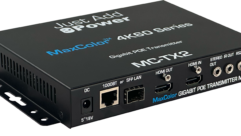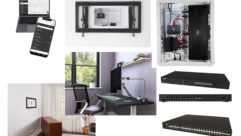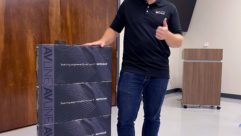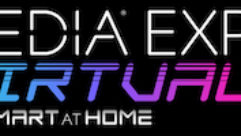
AV Keeps Large Company Connected
Oil refinery installs an automated AV system to broadcast company meetings to employees working in separate locations.
Designing the systemNuts and boltsAn economical multimedia solutionELIMINATING EXTRANEOUS NOISE
CHALLENGE: Create a cost-effective, fully automated AV system capable of broadcasting the company’s daily meetings to personnel dispersed throughout a 555-acre facility.
SOLUTION: Develop a speech sensing, auto- homing camera package that utilizes the existing LAN infrastructure to broadcast and archive all company meetings.
Processing approximately 107,000 barrels of crude oil daily, El Paso, TX-based Western Refining operates two large refinery complexes located directly across the street from one another. Because the company employs roughly 350 people spread over 555 acres, the task of assembling key personnel for daily meetings was a daunting challenge. Eager to find a solution, company management charged Blake Larsen, Western Refining’s manager of information technology, with resolving the issue.
“The objective was to be able to broadcast a large daily meeting to the entire company, because we felt it was important that everyone should watch and listen in as these sessions occurred,” Larsen says. “Management originally envisioned broadcasting these meetings via closed circuit television (CCTV), but due to the cost of implementing such a system, I was eager to explore alternatives.”
The Yellow Page Conference Room at El Paso, TX-based Western Refining includes cameras above the screen, plus tabletop microphones at the moderator’s table and suspended mics over the audience.”/>
The Yellow Page Conference Room at El Paso, TX-based Western Refining includes cameras above the screen, plus tabletop microphones at the moderator’s table and suspended mics over the audience.
Compounding the complexity of the challenge, Larsen wanted a fully automated solution to eliminate the necessity of having a full-time AV tech to operate the system. Larsen solicited bids from various AV design-build firms and ultimately selected a package presented by El Paso, TX-based Howell Electronics that took advantage of the company’s existing LAN infrastructure.
Completed last year at a cost of $45,000, Howell Electronics’ Design Engineer Steve Waltman and his team developed a voice-activated sensing system with auto-homing capability for the cameras, using the digital audio processing and logic control capabilities of the Biamp AudiaFlex system (see sidebar). Shotgun microphones were positioned to create multiple zones within the audience seating area with five gooseneck cardioid microphones supporting the moderator’s table at the front.
With the microphones’ audio signals driving camera activation via AudiaFlex’ logic control, a summed AV feed is then delivered to the company’s Windows Media encoder and server for real-time LAN distribution and archival. Throughout the company, remote viewers use the standard Windows Media Player to observe and listen in on the meeting activities in the Yellow Page Conference Room.
The Yellow Page Room measures 45- by 39-feet, comfortably accommodating an audience of 60 to 70. While the room is carpeted, it’s rather austere in furnishings because many employees attend these meetings in working attire. Hence, the room is quite live and conversation requires very little sound reinforcement.
The microphones installed throughout the room are primarily used for the capture of dialog to be distributed via the company LAN. While there’s a sound reinforcement system consisting of a pair of Electro-Voice SX 100 surface-mount speakers driven by a QSC ISA Series power amplifier, this system is primarily used for pre-recorded materials fed from a Sony SLV-D500P combination DVD/VCR player.
At the front of the room, a table for the meeting panelists with the moderator’s seat at the center is equipped with four Audio-Technica ES915 goose-neck microphones mounted on Audio-Technica AT8615 desk stands. The moderator has a custom-built control station with a brass connector plate and base panel for extra strength and tabletop stability. This station features a fifth Audio-Technica ES915 microphone, a 7-inch LCD video monitor to provide a view of the live video feed as it streams over the refinery’s LAN, and illuminated “On-Air” and “Off-Air” push-buttons. Because the moderator changes almost daily, ease of operation was a high priority for this system.
For audience participation, seven Audio-Technica AT835b condenser mics are suspended from the ceiling with AT8415 shock mounts and Atlas MS12C telescoping mic booms. These mics and their resulting seven zones form a grid pattern that enables the AudiaFlex to activate individual cameras with fixed position coverage, enabling remote viewers to see a close-up of the person speaking. Similarly, the five microphones at the moderator’s table drive the cameras focused on the front of the room.
Mounted with Pelco CM1750 brackets on the front wall above the moderator’s table, six Honeywell ACC484TP high-resolution color cameras are each equipped with Computar CG-TG1020513 varifocal auto iris lenses. These security-grade cameras are focused on various segments of the audience and coincide with the corresponding microphone zones. There are also two additional cameras on the back wall. One provides a view of the moderator/panelists, while the other focuses on company management. The cameras feed directly into a Pelco VA6220 20-channel sequential homing switcher, which is designed to automatically respond to alarm inputs. The switcher incorporates an alarm mode where a dry contact closure calls up a particular camera. The AudiaFlex provides the control signal for the dry contact closure based on its internal logic sensing each time it detects an active microphone, which facilitates rapid and fully automated switching between the moderator/panelists and audience response.
Audio output from the AudiaFlex and video output from the Pelco VA6220 are summed through an Ocean Matrix OMX-7001 video and stereo audio distribution amplifier. From here, signals feed the Windows Media Encoder IP broadcast interface.
Located along the opposite side of the Yellow Page room is a Winsted K8574 locking console that houses the room’s Biamp AudiaFlex, Pelco homing switcher, Sony DVD/VCR player, and QSC Audio power amplifier, as well as two Dell PCs. An Ademco AMC-10 10-inch color monitor is also available for viewing the real-time or archived video stream.
Via an Extron MPS112 media presentation switcher, the system console also provides inputs for projection and/or broadcast of computer graphics, output from a document camera, video camera, DVD/VCR, or other sources. For presentations, the room is equipped with an InFocus LP900 projector and a Da-Lite Model C 120-inch screen. A single snake running from the table controller to the Winsted console brings back the five microphones located at the moderator’s table as well as the video program presented to the moderator, so he or she can monitor the AV stream being transmitted.
FOR MORE INFORMATION
Ademco Groupwww.security.honeywell.com/hsce
Atlas Soundwww.atlassound.com
Audio-Technicawww.audio-technica.com
Biamp Systemswww.biamp.com
Computarwww.cbcamerica.com/cctvprod/computer
Da-Litewww.da-lite.com
Dell Computerwww.dell.com
Electro-Voicewww.electrovoice.com
Extron Electronicswww.extron.com
Honeywellwww.honeywell.com
InFocuswww.infocus.com
Microsoftwww.microsoft.com
Ocean Matrixwww.tecnec.com
Pelcowww.pelco.com
QSC Audiowww.qscaudio.com
Sonywww.sony.com
Winstedwww.winsted.com
To broadcast the company’s meetings, the streaming AV feed is sent to a Windows Media encoder where a Windows 2003 server with Windows Media Services simultaneously multicasts and archives the encoded stream. By working with standard Microsoft tools and applications (AVI file format for use with Windows Media Player), no special software or hardware is required for company personnel to view the meeting, which is another cost-effective aspect of the system. In addition to a full-bandwidth version that’s multicast over the company’s LAN at roughly 2 Mb/s, a second compressed file is also created. This low-bandwidth file is primarily intended for Western Refining’s field personnel who access the company intranet via VPN.
The system’s greatest benefit lies in its ability to provide affordable and effective mass communication. “This installation turned out to be an extremely cost-effective solution for us,” Larsen says. “After Steve Waltman and Howell Electronics came back with an alternative solution that was less than half the cost of the CCTV approach, I was very pleased, as was management.”
For Western Refining, its Biamp AudiaFlex digital audio platform system not only handles signal processing tasks, but also provides the dry contact closure to guide camera selection based upon the active microphone zone.
The AudiaFlex logic program selects from nine separate camera positions to display the scene, including the person addressing the meeting. Cameras viewing the moderator seat and table are assigned priority over audience views and the same holds true for microphone audio, with the AudiaFlex providing slight attenuation over the audience system when speech overlap occurs.
“The greatest challenge of this installation was creating a systematic approach for directing camera coverage over a 1,700-square-foot conference room using only general microphone coverage as the sensory guidance control,” says Howell Electronics’ Design Engineer Steve Waltman. “To accomplish this meant the system must operate with virtual immunity to extraneous noise.”To combat these issues, Waltman first established the basic audio system design using integrated control functionality within AudiaFlex to achieve the primary method of operation. He then applied parametric filtering, auto-mixer logic functionality, and compression/limiting processing, combined with time synchronized logic gates to achieve the final goal: a speech-initiated camera control system merged with local sound reinforcement. Final tuning was later accomplished during live on-air meetings.
Roger Maycock is the owner of MountainCrest Communications in Downey, CA. A recognized music and sound authority, Maycock has written hundreds of technical articles for a number of trade and consumer publications. He can be reached at [email protected].










